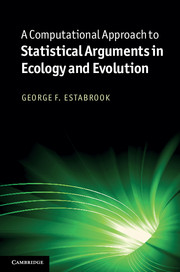Book contents
- Frontmatter
- Contents
- Acknowledgments
- 1 Introduction
- 2 Programming and statistical concepts
- 3 Choosing a test statistic
- 4 Random variables and distributions
- 5 More programming and statistical concepts
- 6 Parametric distributions
- 7 Linear model
- 8 Fitting distributions
- 9 Dependencies
- 10 How to get away with peeking at data
- 11 Contingency
- References
- Index
5 - More programming and statistical concepts
Published online by Cambridge University Press: 05 June 2012
- Frontmatter
- Contents
- Acknowledgments
- 1 Introduction
- 2 Programming and statistical concepts
- 3 Choosing a test statistic
- 4 Random variables and distributions
- 5 More programming and statistical concepts
- 6 Parametric distributions
- 7 Linear model
- 8 Fitting distributions
- 9 Dependencies
- 10 How to get away with peeking at data
- 11 Contingency
- References
- Index
Summary
A question
I went fly fishing with my friend John. We caught 14 fish. He was casting a Blue Bobber and caught six fish, and I was casting a Grimacing Willy and caught eight fish. I wondered, “Do Blue Bobbers tend to catch the same size fish as Grimacing Willies?”
To answer this question using the methods I have presented, I need to: (1) use as data the 14 fish we caught, measured by weight and structured into two groups based on which fly caught them; (2) use as a test statistic a number, calculated from the data, that sums up how much heavier are the fish caught on Blue Bobbers than the fish caught on Grimacing Willies; (3) hypothesize a specific probability mechanism that represents the hypothesis that weights of fish caught on Blue Bobbers are not different from weights of fish caught on Grimacing Willies; (4) put that mechanism in motion to compute a large number of data sets, each similar in structure to the one observed, but constituting a sample of the hypothesis; (5) from each data set calculate a value of the test statistic; (6) sort these values and report them as an estimate of the probability distribution predicted by the hypothesis that fish weights are not different; (7) see where in this predicted distribution the observed weight difference falls; and finally (8) decide whether the observed data seem to be consistent with the hypothesis.
- Type
- Chapter
- Information
- Publisher: Cambridge University PressPrint publication year: 2011



